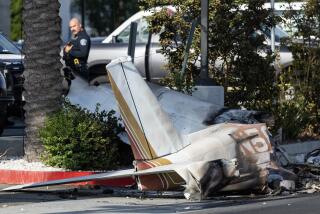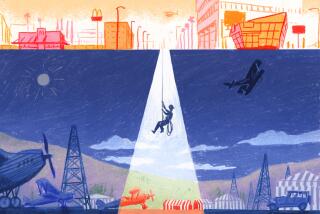Northrop and Hawthorne Airport look back toward their fledgling days with ‘Golden Age of Aviation.’
- Share via
The Northrop Aircraft Co. press release was dated Sept. 1, 1939.
It reported that the fledgling company--then consisting of aircraft design visionary Jack Northrop and six engineers--would build its $500,000 factory on a tract of Hawthorne farmland near the intersection of El Segundo Boulevard and Prairie Avenue.
As a part of the arrangement, the city intended to float a $47,000 bond issue to grade a landing field adjacent to the plant and construct a 3,700-foot runway.
Roy L. Wolford, who set up Northrop’s first photo lab in 1940, recalls taking a picture of the “first little building” when the airfield was still “just wheat stubble.”
Sawtooth structures--called that because of the roof line--soon took shape along the south side of the airfield. They are still there after several additions and remodelings.
“It was part of an adventure because we were doing something new,” Wolford said.
Added Jim Randall, who recently celebrated his 50th anniversary as the company’s longest-tenured employee: “(Jack) Northrop would say to us, ‘You’re doing it, not me.’ ”
Like every other aircraft company, Northrop boomed during World War II. It did subcontracting work, built fighting seaplanes for the Norwegian government, and produced what Wolford called the “first big plane” of its own. That was the P-61 Black Widow, which was the first aircraft built specifically as a night fighter. The “flying wing”--a Jack Northrop concept dating back to the 1920s--also took shape, but the experimental bombers were scrapped by the Air Force in 1953.
Both the airfield and Northrop have grown over the years. Wolford had Badge 200 when he went to work in April, 1940. The company, now known as the Northrop Corp., has 44,600 employees worldwide.
And Northrop Field, where the first landings a half-century ago were on an unpaved runway, is now the Hawthorne Municipal Airport with 120,000 takeoffs and landings a year.
The airport also plays host every year to the Hawthorne Air Faire, which is billed as a weekend of family fun amid aircraft old and new, classic automobiles, food and novelty booths and aerospace exhibitions. Attendance usually runs 15,000 a day.
But this year’s celebration of “The Golden Age of Aviation” on Saturday and Sunday will be all about anniversaries: the 50th birthdays of Northrop and the airport, as well as the the 50th anniversary of the first flights of historic bombers and fighter planes built by General Dynamics/Convair Division and Lockheed.
Vintage World War II planes will arrive in a flyover starting at 1 p.m. Saturday. A current American fighter, the F-111, will fly in at 1 p.m. Sunday.
Sightseeing rides in light aircraft and old-fashioned biplanes will be available for a charge. In the case of the light plane, the cost will be 7 cents a pound. “They’ll have scales to weigh people,” airport Administrator Bob Trimborn said.
People may also rub elbows with aviation pioneers at a dinner held by the Chamber of Commerce on Saturday at 6:30 p.m. at the Stouffer Concourse Hotel, 5400 W. Century Blvd., near Los Angeles International Airport. Among those being honored are Sir Frank Whittle, the inventor of the jet engine, who conducted the first successful laboratory test in England in 1937. The dinner is open to the public by reservation at $40 a person. Call 676-1163.
If the accent will be on history, the latest in Northrop technology--the B-2 Stealth bomber--also will get some attention. Col. Richard Couch and Bruce Hinds, test pilots on the craft’s maiden flight last year, will be at the Northrop exhibit to talk about the plane.
Trimborn notes that the airport and Northrop have had a 50-year “open arms” friendship: When Jack Northrop was shopping for a location, the city helped lure him by building him an airfield, and Northrop brought Hawthorne industry and jobs.
Said Trimborn: “We’ve had 50 years of a very good partnership.”
More to Read
Inside the business of entertainment
The Wide Shot brings you news, analysis and insights on everything from streaming wars to production — and what it all means for the future.
You may occasionally receive promotional content from the Los Angeles Times.










